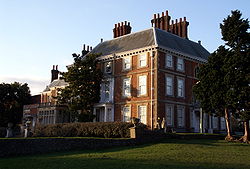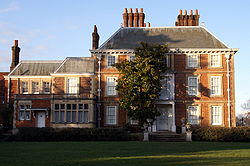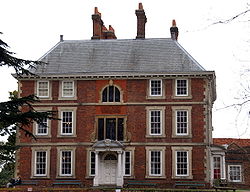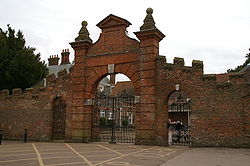
Forty Hall
Encyclopedia

Forty Hill
Forty Hill is a largely residential suburb in the north of the London Borough of Enfield, England. To the north is Bulls Cross, to the south Enfield Town, to the west Clay Hill, and to the east Enfield Highway.- Etymology :...
in Enfield
London Borough of Enfield
The London Borough of Enfield is the most northerly London borough and forms part of Outer London. It borders the London Boroughs of Barnet, Haringey and Waltham Forest...
, north London
North London
North London is the northern part of London, England. It is an imprecise description and the area it covers is defined differently for a range of purposes. Common to these definitions is that it includes districts located north of the River Thames and is used in comparison with South...
. The house, a Grade I listed building, is today used as a museum by the London Borough of Enfield
London Borough of Enfield
The London Borough of Enfield is the most northerly London borough and forms part of Outer London. It borders the London Boroughs of Barnet, Haringey and Waltham Forest...
. Within the grounds is the site of the former Tudor Elsyng Palace
Elsyng palace
Elsyng palace was a Tudor palace, on a site in what are now the grounds of Forty Hall in Enfield. Its exact location was lost for many years until excavations were carried out in the 1960s.-Location:...
.
Location
Forty Hall is located in the north of the London Borough of EnfieldLondon Borough of Enfield
The London Borough of Enfield is the most northerly London borough and forms part of Outer London. It borders the London Boroughs of Barnet, Haringey and Waltham Forest...
, the northern-most borough of London. The hall and formal park are located on the top of Forty Hill
Forty Hill
Forty Hill is a largely residential suburb in the north of the London Borough of Enfield, England. To the north is Bulls Cross, to the south Enfield Town, to the west Clay Hill, and to the east Enfield Highway.- Etymology :...
, a level gravel plateau standing above the flood plain of the River Lea to the east, and the valley of the Turkey Brook
Turkey Brook
Turkey Brook rises near the Fir and Pond Woods Local Nature Reserve near Potters Bar, Hertfordshire.- Etymology :The brook named from the street which is recorded as Tokestreete 1441, Tuckhey strete 1610, Tuckey street 1615, Turkey street 1805, probably 'street of houses associated with a family...
to the north and west. The park slopes down into the valley, where the remains of old ponds lie on the London Clay
London Clay
The London Clay Formation is a marine geological formation of Ypresian age which crops out in the southeast of England. The London Clay is well known for the fossils it contains. The fossils from the Lower Eocene indicate a moderately warm climate, the flora being tropical or subtropical...
. A loop in the former course of the New River
New River (England)
The New River is an artificial waterway in England, opened in 1613 to supply London with fresh drinking water taken from the River Lea and from Amwell Springs , and other springs and wells along its course....
forms the boundary of much of the estate, though this has since been re-routed to the east. To the north are Whitewebbs and Myddelton House
Bulls Cross, Enfield
Bulls Cross is a hamlet located in the London Borough of Enfield, North London, and is part of London's Metropolitan Green Belt.-Etymology:Bulls Cross is recorded as Bedelscrosse in 1465. Recorded thus in c.1580 and on the Ordnance Survey map of 1822...
. The road to the east was formerly the main route from Enfield to Waltham Cross
Waltham Cross
Waltham Cross is the most southeasterly town in Hertfordshire, England. It is 12 miles from the City of London and immediately north of the M25 motorway, forming part of the Greater London Urban Area and London commuter belt. Part of Waltham Cross is located within Greater London.-Geography:It is...
, but traffic has been re-routed towards to A10.
History



Haberdasher
A haberdasher is a person who sells small articles for sewing, such as buttons, ribbons, zips, and other notions. In American English, haberdasher is another term for a men's outfitter. A haberdasher's shop or the items sold therein are called haberdashery.-Origin and use:The word appears in...
and Lord Mayor of London
Lord Mayor of London
The Right Honourable Lord Mayor of London is the legal title for the Mayor of the City of London Corporation. The Lord Mayor of London is to be distinguished from the Mayor of London; the former is an officer only of the City of London, while the Mayor of London is the Mayor of Greater London and...
from 1632 to 1633. However Tuff states that it was built by Sir Hugh Fortee and bought by Raynton, quoting a 1635 survey describing a copyhold house some time Hugh Fortee's, and late Sir Thomas Gurney's. Lambert also gives Fortee as the origin of the name.
The detailed history of the house has until recently been poorly understood, since it is known to have been built in the 1620s, but has the external appearance of an 18th century house. A detailed examination was carried out for Enfield council as part of the Forty Hall Conservation Plan. This concluded that the house was probably not designed by a famous architect such as Inigo Jones, but by a 'clever artisan builder'.
The original square house was not altered much in the 17th century other than a small extension to the north-west in 1636. On 1640 Rainton was imprisoned for refusing to help Charles I
Charles I of England
Charles I was King of England, King of Scotland, and King of Ireland from 27 March 1625 until his execution in 1649. Charles engaged in a struggle for power with the Parliament of England, attempting to obtain royal revenue whilst Parliament sought to curb his Royal prerogative which Charles...
raise a loan. He died in 1646 aged 77 and was buried at St Andrew's Church in Enfield. The hall then passed to his son, also Nicholas. He was able to extend the estate northwards by buying and demolishing neighbouring Elsyng Palace
Elsyng palace
Elsyng palace was a Tudor palace, on a site in what are now the grounds of Forty Hall in Enfield. Its exact location was lost for many years until excavations were carried out in the 1960s.-Location:...
in 1656. In 1696 the hall passed to John Wolstenholme (probably a descendent of the financier and merchant of the same name and member of the Virginia Company
Virginia Company
The Virginia Company refers collectively to a pair of English joint stock companies chartered by James I on 10 April1606 with the purposes of establishing settlements on the coast of North America...
), who carried out major refurbishment possibly following a fire, including construction of an extension to the south-west, and planted the avenue. In 1740 the house passed to Eliab Breton, who remodelled the ground floor. Later owners included Edmund Armstrong (1787) and James Meyer (1799), whose family built the nearby Jesus church in 1835. In 1894 the hall was bought by Henry Carrington Bowles of neighbouring Myddelton House for his son Major Henry Ferryman Bowles (1858–1943), MP for Enfield
Enfield (UK Parliament constituency)
Enfield was a parliamentary constituency of Middlesex centred on the town of Enfield. The area formed part of the London conurbation. It returned one Member of Parliament to the House of Commons of the Parliament of the United Kingdom, elected by the first past the post system.-History:The...
and later 1st Baronet Bowles. In 1897 there were further changes including enlargement of the south-west wing. In 1951 the Bowles family sold it to the Municipal Borough of Enfield
Municipal Borough of Enfield
Enfield was a local government district in Middlesex, England from 1850 to 1965.The parish of Enfield adopted the Public Health Act 1848 in 1850, and formed a local board of health of 12 members to govern the area. The local board's area was reconstituted by the Local Government Act 1894, and...
, the predecessor of the London Borough of Enfield. It has since been used as a museum.
The Hall closed to the public in late 2010 for a major redevelpoment project; it is scheduled to re-open in Spring 2012. Plans include the restoration of the original position of the staircase.
Forty Hall museum
The museum focuses on the history of the area now covered by the London Borough of Enfield, with an emphasis on household objects, including complete tea and dinner services. Seventeenth and eighteenth-century pottery includes English tin-glazed ware and stonewareStoneware
Stoneware is a vitreous or semi-vitreous ceramic ware with a fine texture. Stoneware is made from clay that is then fired in a kiln, whether by an artisan to make homeware, or in an industrial kiln for mass-produced or specialty products...
, creamware
Creamware
Creamware is a cream-coloured, refined earthenware created about 1750 by the potters of Staffordshire, England, which proved ideal for domestic ware. It was popular until the 1840s. It was also known as tortoiseshellware or Prattware depending on the colour of glaze used...
, pearlware, black basalt ware, German stoneware, and Chinese and English porcelain
Porcelain
Porcelain is a ceramic material made by heating raw materials, generally including clay in the form of kaolin, in a kiln to temperatures between and...
. 19th and 20th-century china includes china by Royal Doulton
Royal Doulton
The Royal Doulton Company is an English company producing tableware and collectables, dating to 1815. Operating originally in London, its reputation grew in The Potteries, where it was a latecomer compared to Spode, Wedgwood and Minton...
, Moorcroft
Moorcroft
Moorcroft is a British pottery manufacturer based in Burslem, Stoke-on-Trent, Staffordshire, which was founded by William Moorcroft.-History:...
, Wedgwood
Wedgwood
Wedgwood, strictly speaking Josiah Wedgwood and Sons, is a pottery firm owned by KPS Capital Partners, a private equity company based in New York City, USA. Wedgwood was founded on May 1, 1759 by Josiah Wedgwood and in 1987 merged with Waterford Crystal to create Waterford Wedgwood, an...
, Minton and Poole Pottery
Poole Pottery
Poole Pottery is a pottery manufacturer, originally based in Poole, Dorset, England. The company was founded in 1873 on Poole quayside, where it continued to produce pottery by hand before moving its factory operations away from the quay in 1999. Production continued at the new site in Sopers Lane...
, and decorative work by Clarice Cliff
Clarice Cliff
Clarice Cliff was an English ceramic industrial artist active from 1922 to 1963.Cliff was born in Tunstall, Stoke-on-Trent, England.- Early life :...
, Susie Cooper
Susie Cooper
Susie Cooper was a prolific English ceramic designer working in the Stoke-on-Trent pottery industries from the 1920s to the 1980s.-Life and work:Born in Stanfields, Stoke-on-Trent, she was the youngest of seven children...
, Charlotte Rhead
Charlotte Rhead
Charlotte Rhead was an English ceramics designer active in the 1920s and the 1930s in the Potteries area of Staffordshire.Charlotte Rhead was born into an artistic family...
and Keith Murray
Keith Murray (ceramic artist)
Keith Day Pearce Murray was a New Zealand born architect and designer who worked as a ceramics, glass and metalware designer for Wedgwood in the Potteries area of Staffordshire in the 1930s and 1940s. He is considered one of the most influential designers of the Art deco style.Murray was born in...
. Glassware includes wine glasses, flasks, decanters, phials and bottles.
In addition the museum holds finds from excavations by the Enfield Archaeological Society. Roman
Ancient Rome
Ancient Rome was a thriving civilization that grew on the Italian Peninsula as early as the 8th century BC. Located along the Mediterranean Sea and centered on the city of Rome, it expanded to one of the largest empires in the ancient world....
pottery and glass includes a complete brown glass flagon. Later (15th to 17th century) finds from Elsyng Palace include pottery, glass and polychrome
Polychrome
Polychrome is one of the terms used to describe the use of multiple colors in one entity. It has also been defined as "The practice of decorating architectural elements, sculpture, etc., in a variety of colors." Polychromatic light is composed of a number of different wavelengths...
, tin-glazed ware tiles.
The grounds

Metropolitan Green Belt
The Metropolitan Green Belt is a statutory green belt around London, England. It includes designated parts of Greater London and the surrounding counties of Bedfordshire, Berkshire, Buckinghamshire, Essex, Hertfordshire, Kent and Surrey in the South East and East of England regions.-History:The...
. Around the house are formal gardens and a small lake. The remainder includes a park that is open to the public and a farm. An avenue of trees runs down the hill from the house into the valley of the Turkey Brook
Turkey Brook
Turkey Brook rises near the Fir and Pond Woods Local Nature Reserve near Potters Bar, Hertfordshire.- Etymology :The brook named from the street which is recorded as Tokestreete 1441, Tuckhey strete 1610, Tuckey street 1615, Turkey street 1805, probably 'street of houses associated with a family...
, also known locally as Maidens Brook. The northern and much of the southern boundary are marked by the former course of the New River
New River (England)
The New River is an artificial waterway in England, opened in 1613 to supply London with fresh drinking water taken from the River Lea and from Amwell Springs , and other springs and wells along its course....
.
External links
- Forty Hall - Enfield Council
- Enfield Museum Service
- Forty Hall on the VisitWoods website

